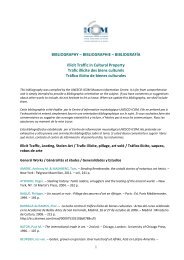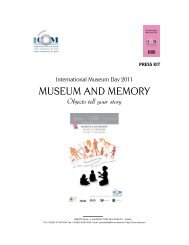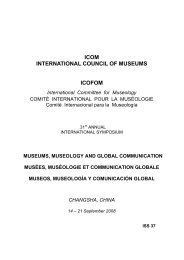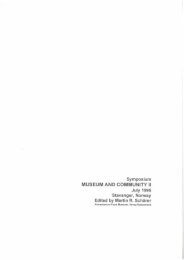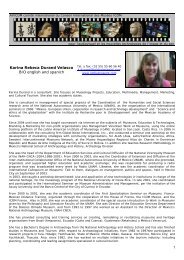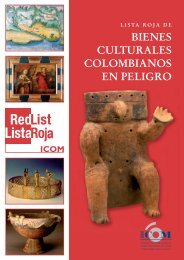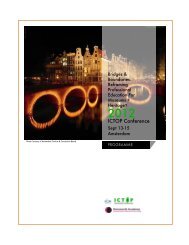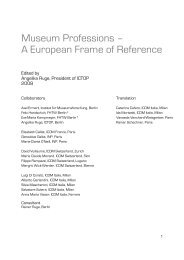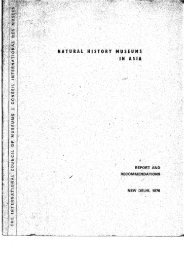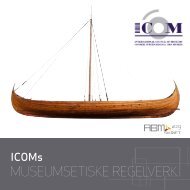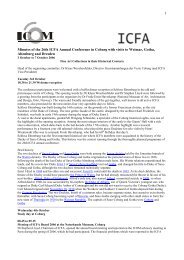Key Concepts of Museology - ICOM
Key Concepts of Museology - ICOM
Key Concepts of Museology - ICOM
You also want an ePaper? Increase the reach of your titles
YUMPU automatically turns print PDFs into web optimized ePapers that Google loves.
with the overall work <strong>of</strong> the museum,<br />
from preventive conservation to the<br />
information disseminated to different<br />
publics. The museographer differs<br />
from the exhibit designer; a term<br />
proposed to indicate the person with<br />
all the skills required to create exhibitions,<br />
whether these are situated in<br />
a museum or in a non-museal setting,<br />
and from the exhibition designer in<br />
that the latter, who uses techniques to<br />
set the scene for the exhibition, may<br />
also fi nd himself skilled at setting up<br />
an exhibition (see Museography). The<br />
pr<strong>of</strong>essions <strong>of</strong> exhibit designer and<br />
exhibition designer have long been<br />
related to that <strong>of</strong> decorator, which<br />
refers to decoration <strong>of</strong> the spaces.<br />
But the work <strong>of</strong> interior decoration<br />
in functional areas pertaining to the<br />
normal activities <strong>of</strong> interior decoration<br />
differs from the tasks that are<br />
required for exhibitions, which are in<br />
the fi eld <strong>of</strong> exhibit design. In exhibitions,<br />
their work tends more towards<br />
fi tting out the space using exhibits as<br />
elements <strong>of</strong> decoration, rather than<br />
starting from the exhibits to be displayed<br />
and given meaning within<br />
the space. Many exhibit designers<br />
or exhibition designers call themselves<br />
fi rst <strong>of</strong> all architects <strong>of</strong> interior<br />
design, which does not mean that any<br />
architect <strong>of</strong> interior design can claim<br />
the status <strong>of</strong> exhibit designer or exhibition<br />
designer, or <strong>of</strong> museographer.<br />
In this context the exhibition and<br />
display curator (a role <strong>of</strong>ten played by<br />
the curator, but sometimes by a person<br />
from outside the museum) takes<br />
on its full meaning, since he or she<br />
produces the scientifi c project for the<br />
exhibition and coordinates the entire<br />
project.<br />
3. Assisted by the development <strong>of</strong><br />
the museal fi eld, a number <strong>of</strong> pr<strong>of</strong>essions<br />
have gradually emerged and<br />
to become independent, and also to<br />
confi rm their importance and their<br />
will to be a part <strong>of</strong> the museum’s<br />
destinies. This phenomenon can<br />
essentially be observed in the fi elds<br />
<strong>of</strong> preservation and communication.<br />
In preservation, it was fi rst <strong>of</strong> all the<br />
conservator, as a pr<strong>of</strong>essional with<br />
scientifi c competences and above<br />
all the techniques required for the<br />
physical treatment <strong>of</strong> the collection<br />
objects (restoration, preventive and<br />
remedial conservation), who required<br />
highly specialised training (by<br />
types <strong>of</strong> material and techniques),<br />
competences which the curator does<br />
not have. Similarly the tasks imposed<br />
by the inventory, relating to management<br />
<strong>of</strong> the reserves, and also to the<br />
moving <strong>of</strong> items, favoured the relatively<br />
recent creation <strong>of</strong> the post <strong>of</strong><br />
registrar, who is responsible for the<br />
movement <strong>of</strong> objects, insurance matters,<br />
management <strong>of</strong> the reserves and<br />
sometimes also the preparation and<br />
mounting <strong>of</strong> an exhibition (at which<br />
point the registrar becomes the exhibition<br />
curator).<br />
4. Regarding communication, the<br />
staff attached to the educational<br />
department, along with all the staff<br />
who work in public relations, have<br />
benefi ted from the emergence <strong>of</strong><br />
a number <strong>of</strong> specifi c pr<strong>of</strong>essions.<br />
Undoubtedly one <strong>of</strong> the oldest <strong>of</strong><br />
these is that <strong>of</strong> guide-interpreter,<br />
69



